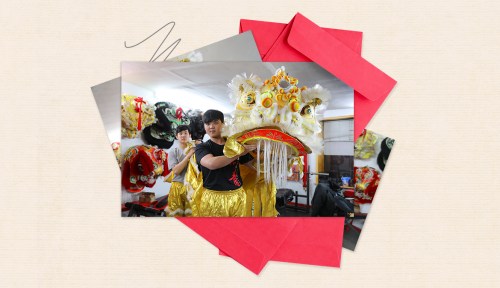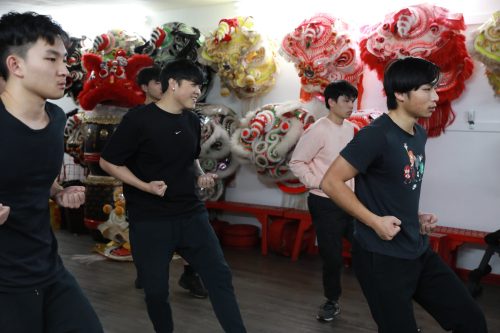‘I’m a Lion Dancer, and Here’s What I Do During My Weekly 3-Hour Practices’
Xing Long Lin is a lion dancer in New York City. Here's what's required to perform the art form, including long, physically tough practices.

In a studio located on Canal Street in New York City’s Chinatown, Xing Long Lin, a 22-year old entrepreneur and founder of an online clothing and shoe brand, is holding one of the nine lion-dance stances as he practices for a Lunar New Year performance. In addition to his full-time job, he is also lion dancer—an unpaid role that demands three-plus hours of physically demanding practice each week and availability to perform at dozens of celebrations, including the annual Lunar New Year and also store openings and weddings. The art form is representative of warding off evil spirits and bringing good luck.
Experts in This Article
Lion dancing is believed to have been “introduced into China during the Tang Dynasty with the arrival of Buddhism” thousands of years ago and has origins in Chinese, Japanese, Vietnamese, Korean, and other Asian cultures, says Jonathan H. X. Lee, PhD, professor of Asian American studies at San Francisco State University.
Lin, who has been a lion dancer for six years, says it is important to him because it allows him to help spread appreciation for Asian culture, bring the community together, and share this tradition with younger generations. For the past four years, Lin has performed with the New York Chinese FreeMasons Athletic Club (NYCFAC), a nonprofit organization that educates youth about Chinese heritage through lion dance, martial arts, and athletics. He and his troupe of 20 other lion dancers perform between 30 and 40 shows a year, each running between eight and 20 minutes.
Here’s how lion dancing plays into Lin’s life.

What weekly 3-hour lion-dancing practices are like
A lot of behind-the-scenes work goes into each of Lin’s lion-dancing performances. Practices, which occur weekly on Thursdays for at least three hours all year long, involve a combination of stretches, strength-training exercises, and a dance practice with the lion costume on. “We do a lot of workouts, like push-ups and horse stance, which is like a halfway squat,” says Lin. “We just hold the squat position for five to 10 minutes.” In total, Lin goes through nine stances in each practice, totaling at about an hour of stance-holding practice.
“We do a lot of workouts, like push-ups and horse stance, which is like a halfway squat. We just hold the squat position for five to 10 minutes.” —Xing Long Lin, lion dancer
Being adept at holding stances is essential in lion dancing because the performances involve squatting and stacking for long periods of time. Stacking involves a dancer holding an ornamental lion head while in a variety of stances, atop another dancer who is controlling the rear end of the lion.
Gold Medal Couple Tara Davis-Woodhall and Hunter Woodhall Talk Marriage, Motivation, and Their Next Chapter With Nike

Coach Kara Lawson Wants You to ‘Handle Hard Better’—and Here Are 3 Ways to Do Just That

JuJu Watkins Leaves March Madness With ACL Tear—and This Knee Injury Is More Common Than You Think

Following stance practice, Lin trains for an additional two hours in the lion-dancing uniform—which consists of a colorful lion head the dancer holds and shimmery pants embellished in fur they wear—to run routines and choreographed dances to the beat of the drums, which represents the heartbeat of the lion. Lee says the lion head weighs roughly 20 pounds and “it can get warm in the full costume.”
Beyond the physically demanding workouts, Lin also faces time constraints with his busy schedule. “I sacrifice my time to be here,” he says. In addition to the weekly three-hour workouts (which often run longer than scheduled), the dancers sometimes practice on their own.

Challenges to the future of lion-dancing
The NYCFAC does not pay its lion dancers, and the funds it raises from performance fees help to keep the club’s doors open. “It’s more of volunteer kind of work,” says Brandon Lee, president of the NYCFAC, who has been instructing and coordinating lion dances past three years. “We are a nonprofit trying to spread Chinese culture and help out the community and the youth. The club is open to any of our members, any day of the week to work out. The younger kids come up and they do their homework or play games.”
Lee says any proceeds get funneled back into the organization to pay rent for the studio space, new equipment, and occasional meals for the dancers and dancing staff after the shows. The funds are also used to purchase new lion heads, which primarily come from China and Hong Kong and cost between $800 and $1,500 each.

Recruitment is another challenge for keeping the art form alive. Lin says, in his experience, younger people aren’t as interested in learning about and practicing lion dancing as they once were. Lee agrees: Today “it’s more about word of mouth and knowing people,” he says. “We [at the NYCFAC] are trying to explore other [recruitment] methods.”
But all of these challenges are worth the commitment because lion dancing is more than just a tradition to Lin. “Serving in this role means a lot to me because this is my own culture, the club pushes me a lot [physically and mentally], and lion dancing allows me to serve as a role model to other Chinese kids,” he says. “When people hire us, I always tell the kids watching us to post about us on social media, so other people can see what we’re doing in the community.” He hopes that social media traction will raise the club’s visibility and lead to more people in his community joining, preserving the art form for generations to come.
Sign Up for Our Daily Newsletter
Get all the latest in wellness, trends, food, fitness, beauty, and more delivered right to your inbox.
Got it, you've been added to our email list.







